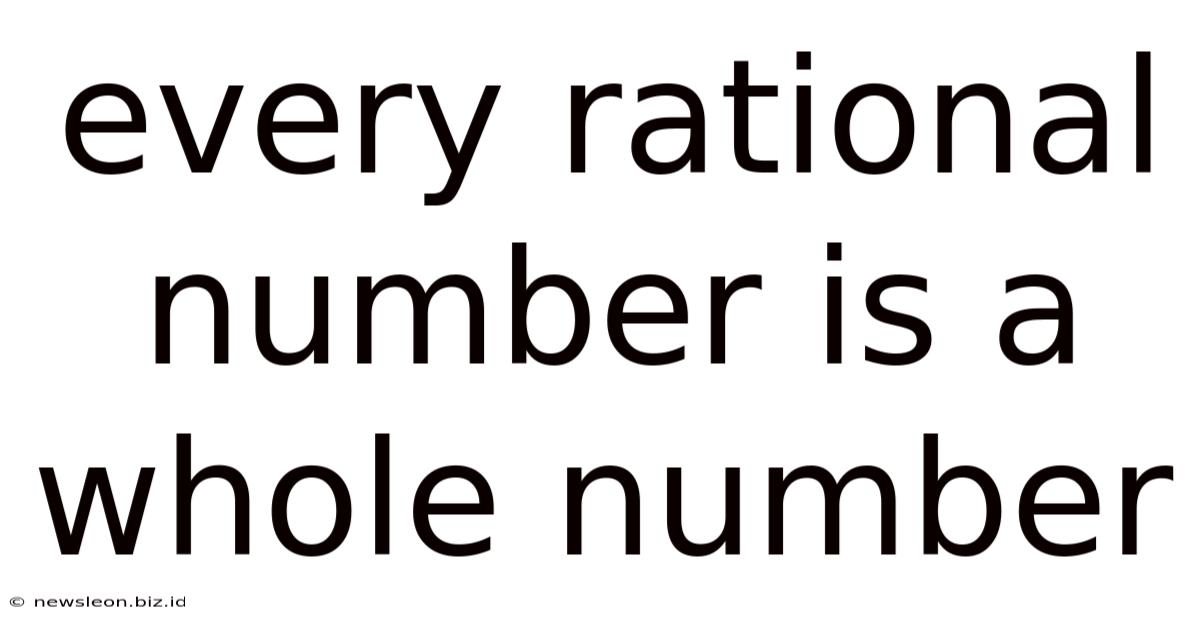Every Rational Number Is A Whole Number
News Leon
Apr 13, 2025 · 4 min read

Table of Contents
Every Rational Number is a Whole Number: A Falsehood and Exploration of Number Systems
The statement "every rational number is a whole number" is false. This article will delve into the intricacies of number systems, exploring the distinctions between whole numbers, integers, rational numbers, and irrational numbers to demonstrate why this statement is incorrect and to provide a comprehensive understanding of the relationships between these number sets. We'll examine specific examples, definitions, and proofs to solidify this concept.
Understanding Number Systems
Before dissecting the statement's falsehood, it's crucial to establish a solid understanding of different number systems:
1. Natural Numbers (Counting Numbers): These are the numbers we use for counting: 1, 2, 3, 4, and so on. They are denoted by the symbol ℕ.
2. Whole Numbers: This set includes all natural numbers and zero (0). It's denoted by the symbol ℤ₀ or sometimes 𝕎.
3. Integers: This set comprises all whole numbers and their negative counterparts: ..., -3, -2, -1, 0, 1, 2, 3, ... They are denoted by the symbol ℤ.
4. Rational Numbers: These are numbers that can be expressed as a fraction p/q, where 'p' and 'q' are integers, and 'q' is not equal to zero (q ≠ 0). Examples include 1/2, -3/4, 5 (which can be written as 5/1), and 0 (which can be written as 0/1). They are denoted by the symbol ℚ.
5. Irrational Numbers: These are numbers that cannot be expressed as a fraction of two integers. They have decimal representations that are non-terminating and non-repeating. Famous examples include π (pi) and √2 (the square root of 2).
6. Real Numbers: This encompasses all rational and irrational numbers. It represents all numbers that can be plotted on a number line. They are denoted by the symbol ℝ.
Why the Statement is False: A Counterexample
The assertion that every rational number is a whole number is demonstrably false because rational numbers encompass a much broader range of numbers than whole numbers. A simple counterexample suffices to disprove the statement.
Consider the rational number 1/2. This number is clearly a rational number because it can be expressed as a fraction (p/q) where p = 1 and q = 2 (both integers, and q ≠ 0). However, 1/2 is not a whole number. Whole numbers are 0, 1, 2, 3, and so on. 1/2 falls between 0 and 1, not within the set of whole numbers.
This single counterexample is enough to definitively refute the statement. Many other rational numbers, such as -3/4, 7/5, and 0.25 (which is equivalent to 1/4), further illustrate the falsity of the original claim.
Exploring the Relationship Between Rational and Whole Numbers
While not every rational number is a whole number, there's an important relationship: all whole numbers are rational numbers. This is because any whole number can be expressed as a fraction with a denominator of 1. For example:
- 5 can be written as 5/1
- 0 can be written as 0/1
- 100 can be written as 100/1
This means that the set of whole numbers is a subset of the set of rational numbers. In set notation, we can represent this as: ℤ₀ ⊂ ℚ.
Visualizing the Number Systems
Imagine a series of nested circles, each representing a number system. The smallest circle would be the natural numbers (ℕ). The next circle, encompassing the natural numbers, would be the whole numbers (ℤ₀). The next larger circle, containing the whole numbers, would be the integers (ℤ). Next comes the rational numbers (ℚ), which include all the integers and many more numbers between the integers. Finally, the largest circle would represent the real numbers (ℝ), encompassing both rational and irrational numbers. This visualization helps to grasp the hierarchical relationship between these sets.
Implications and Further Exploration
The understanding of number systems is fundamental in mathematics and many related fields like computer science, engineering, and physics. Incorrectly assuming that all rational numbers are whole numbers can lead to errors in calculations and logical reasoning.
Further exploration might involve:
-
Decimal Representations: Analyzing the decimal representations of rational and irrational numbers helps distinguish between terminating (e.g., 0.25) and non-terminating (e.g., π) decimals.
-
Density of Rational Numbers: Understanding that rational numbers are dense on the number line, meaning that between any two rational numbers, there exists another rational number.
-
Proofs and Formal Logic: Exploring formal mathematical proofs related to the properties of rational and whole numbers.
Conclusion
The statement "every rational number is a whole number" is unequivocally false. This article has provided a thorough explanation of the different number systems, highlighted the key distinctions between whole and rational numbers, and used counterexamples to disprove the initial assertion. Understanding the relationships between these number systems is crucial for building a strong foundation in mathematics and related disciplines. Remember, all whole numbers are rational, but not all rational numbers are whole numbers. This fundamental concept forms the basis for more advanced mathematical concepts and applications. The ability to differentiate between these number sets is critical for accurate calculations, logical reasoning, and a deeper appreciation of mathematical structures. This fundamental knowledge allows for more complex mathematical exploration and application in diverse fields.
Latest Posts
Related Post
Thank you for visiting our website which covers about Every Rational Number Is A Whole Number . We hope the information provided has been useful to you. Feel free to contact us if you have any questions or need further assistance. See you next time and don't miss to bookmark.